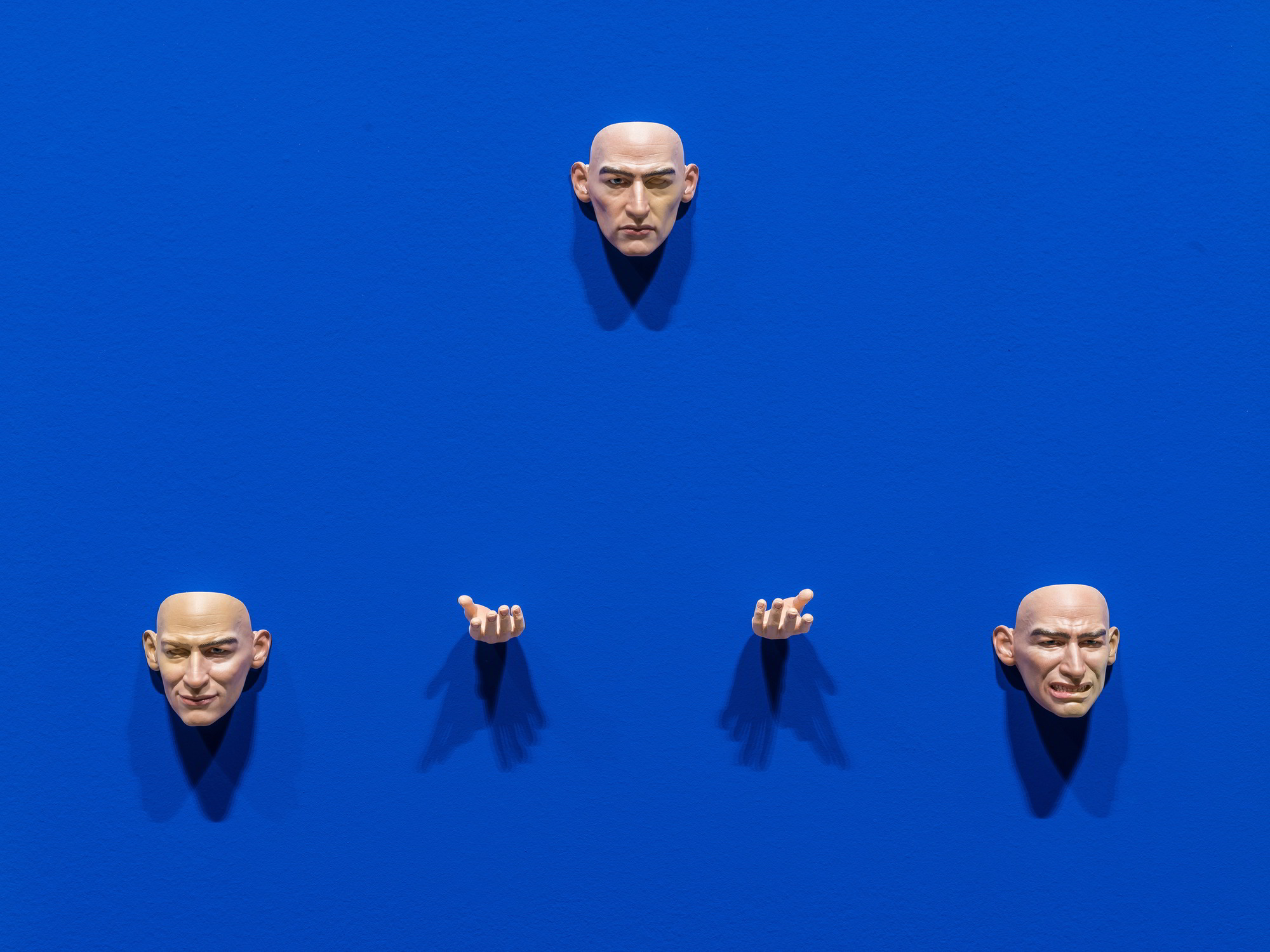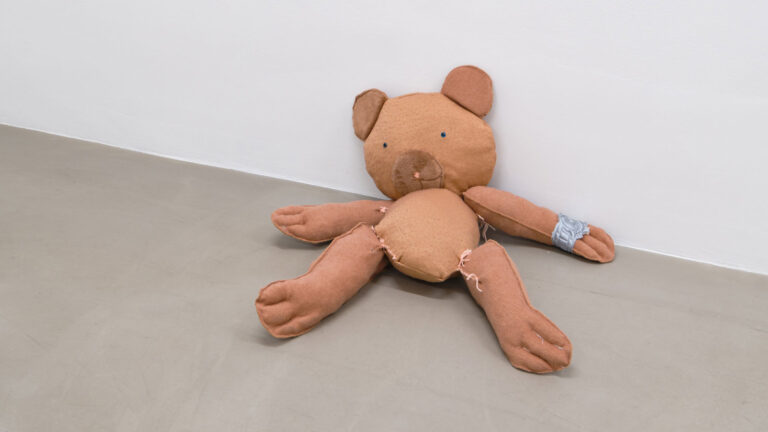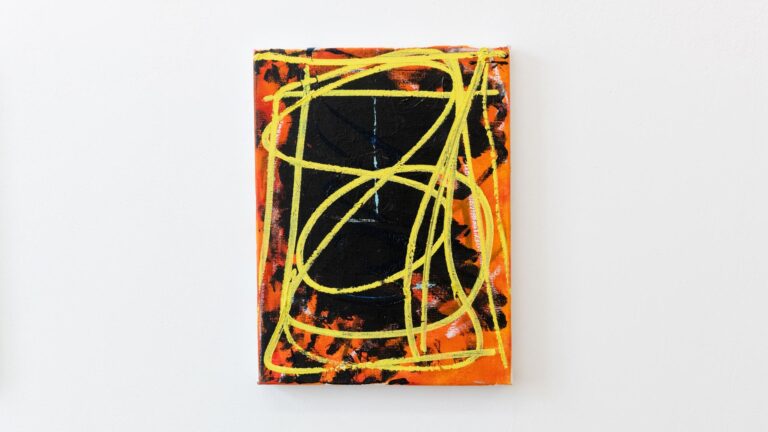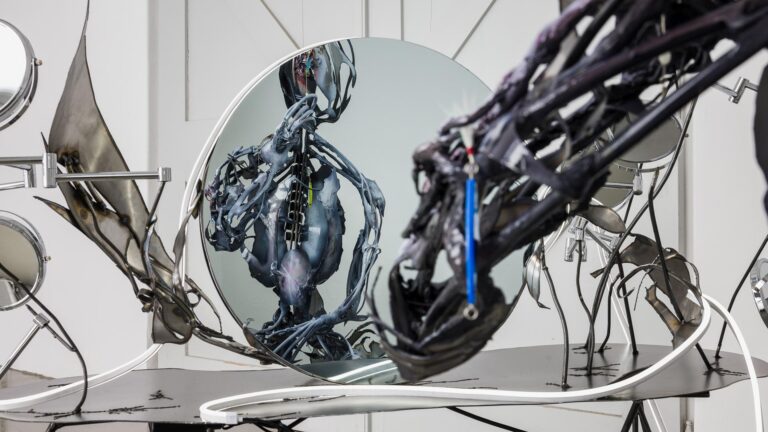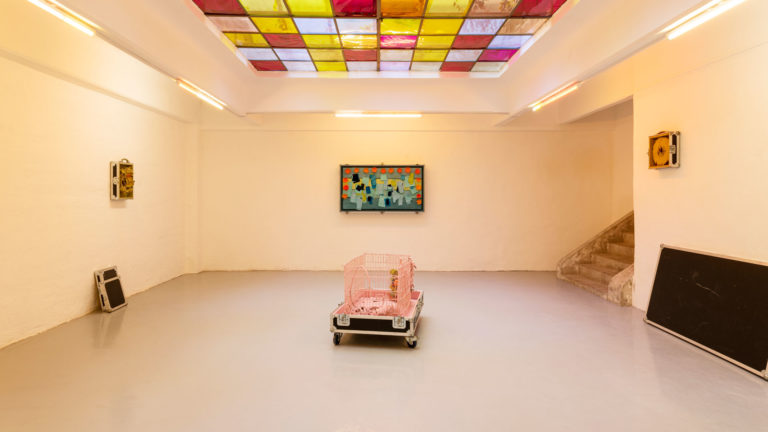Artist: Cécile B. Evans
Exhibition title: AMOS’ WORLD: Episode One
Curated by: Marianne Dobner
Venue: mumok, Vienna, Austria
Date: March 23 – July 1, 2018
Photography: all images copyright and courtesy of the artist and mumok, Vienna
In her work, American–Belgian artist Cécile B. Evans examines the significance and role of emotion in contemporary societies while looking at the increasing influence of new technologies on our feelings and actions. For her solo show at mumok, Cécile B. Evans presents a re-configuration of the work AMOS’ WORLD: Episode One. In total, three episodes are planned of which Episode Two is currently in the making.
AMOS’ WORLD is a three-part television series that takes place in a socially progressive housing estate inspired by famous Brutalist housing complexes such as Le Corbusier’s Unités d’Habitation in Marseille, Berlin, and Nantes-Rezé (1952—57), Alison and Peter Smithson’s Robin Hood Gardens in London (1972), and Moshe Safdie’s Habitat 67 in Montreal (1967). The aim was to encourage perfect individual-communal living communes for the capitalist age—yet they nearly always failed, as people did not conform to the behaviors envisioned by the architects.
The first episode of AMOS’ WORLD introduces the title character Amos, who represents the stereotype of the frustrated, angry white man. He exudes an arrogance that belies his true, slightly pathetic nature, and he almost enjoys wallowing in the grotesqueness of his own actions. He additionally resembles a cross between Antoine de Saint-Exupéry’s fallen-to-earth Little Prince, and architects Le Corbusier and Peter Smithson, who co-designed the famous London social housing estate Robin Hood Gardens, only to later describe the tenants disparagingly as contributors to the building’s decline.
Amos is played by a three-dimensional puppet with a digitally rendered face, and the other characters—inhabitants of the estate, and the Weather, a narrative voice as well as a kind of benevolent foil to Amos—are a mixture of real and animated performers. As in all good television, the subject of the title, Amos, is never the actual subject. As the drama unfolds, what was presented as a utopian living situation becomes ever more psychologically challenging—the characters’ emotional and physical needs are revealed to be in conflict with what those who constructed this society believe to be “good.” Fissures in this carefully constructed network reveal a breakdown of person-to-person and person-to-infrastructure power dynamics, as the audience themselves look on from units nested within an architectural construction built to echo that on screen.
Long before the internet, television was the site of broadcasts in which a mirroring, or projection, of Western societies’ various selves occurred, a fact which also led to the artist’s decision to choose a TV series as a suitable format for her work.
The collective narcissism of daily life and cognitive dissonance are key themes of Cécile B. Evans’s new fictional television series AMOS’ WORLD. Evans asks a series of questions about contemporary life: How does the “self” in the digital age reconcile the gap between perceived freedom and control by the network? Is the “architect” who built the system the cause, or are those who use the structures also responsible for the world they inhabit? And when, if ever, do we become aware of our narcissistic subjectivity and realize that there was another viewpoint all along?
Cécile B. Evans (born 1983) is an American-Belgian artist living and working in London. Recent selected solo exhibitions include Castello di Rivoli (IT), Galerie Emanuel Layr, Vienna (AT), Tate Liverpool (UK), Kunsthalle Aarhus (DK), M Museum Leuven (BE), and De Hallen Haarlem (NL).
Her work has been included amongst others at Haus der Kunst (DE), Mito Art Tower (JP), Renaissance Society Chicago (US), the 7th International Moscow Biennale (RU), the 4th Ural Industrial Biennial (RU), Galerie Kamel Mennour (FR), and Louisiana Museum of Modern Art, Copenhagen (DK), the 9th Berlin Biennale (DE), the 20th Sydney Biennale (AUS), Fundació Joan Miró, Barcelona (ES), and Musée d’Art Moderne de Paris (FR). Public collections include The Museum of Modern Art, New York (US), The Rubell Family Collection, Miami (US), Whitney Museum of American Art (US), De Haallen, Haarlem (NL), Castello di Rivoli, Turin (IT), Louisiana Museum of Modern Art, Copenhagen (DK), and FRAC Auvergne (FR).
Parts of the text ©Kathy Noble/Mousse Magazine
An exclusive artist’s edition will be released on the occasion of the exhibition.
Cécile B. Evans, Production Still: AMOS‘ WORLD, 2017, Credit: Yuri Pattison
Cécile B. Evans, Video Still: AMOS‘ WORLD: Episode One, 2017, Courtesy the artist and Galerie Emanuel Layr, Vienna/Rome
Cécile B. Evans, Video Still: AMOS‘ WORLD: Episode One, 2017, Courtesy the artist and Galerie Emanuel Layr, Vienna/Rome
Cécile B. Evans, Video Still: AMOS‘ WORLD: Episode One, 2017, Courtesy the artist and Galerie Emanuel Layr, Vienna/Rome
Cécile B. Evans, Video Still: AMOS‘ WORLD: Episode One, 2017, Courtesy the artist and Galerie Emanuel Layr, Vienna/Rome
Cécile B. Evans, AMOS’ WORLD: Episode One, mumok, 23. Exhibition view, March 23, to July 1, 2018 © mumok/Klaus Pichler
Cécile B. Evans, AMOS’ WORLD: Episode One, mumok, 23. Exhibition view, March 23, to July 1, 2018 © mumok/Klaus Pichler
Cécile B. Evans, AMOS’ WORLD: Episode One, mumok, 23. Exhibition view, March 23, to July 1, 2018 © mumok/Klaus Pichler
Cécile B. Evans, AMOS’ WORLD: Episode One, mumok, 23. Exhibition view, March 23, to July 1, 2018 © mumok/Klaus Pichler
Cécile B. Evans, AMOS’ WORLD: Episode One, mumok, 23. Exhibition view, March 23, to July 1, 2018 © mumok/Klaus Pichler
Cécile B. Evans, AMOS’ WORLD: Episode One, mumok, 23. Exhibition view, March 23, to July 1, 2018 © mumok/Klaus Pichler







